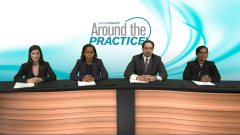
Measuring Treatment Response Following Induction Therapy in Patients with MM
Nausheen Ahmed, MD, discusses the measurement of treatment response following induction therapy in patients with multiple myeloma.
Episodes in this series

Transcript:
Al-Ola Abdallah, MD: Coming back to you, Nausheen. Patients, whether they get quadruple therapy or RVd [lenalidomide, bortezomib, dexamethasone] from community doctors, they’re going to go for transplant. They come to your office, I know there is a great system that you have, but you always look at adequate response. I have been in a lot of arguments about the type of response. I see it [with] community doctors; if they’re not happy with the response they completely change the treatment and delay sending the patients to transplant. What are your thoughts about that? What’s the definition of adequate response [where] you can tell the local oncologist, this cycle’s enough and we can move on for a transplant?
Nausheen Ahmed, MD: DrAbdallah, this is a very good question and often asked by most of the doctors who refer the patients. It kind of also segues into what you were talking about for MRD [minimal residual disease] testing. How deep do we want a response before we go into a transplant? And what’s the significance of getting a complete response [CR] before transplant vs a complete response after transplant? I think the studies are all over the place, so there’s no great data to support that you need a CR right before transplant. Although the general thought is that CR either right before the transplant, or early CR right after the transplant would translate into a better PFS [progression-free survival] and better outcomes. But again, the data are all over the place.
So, in general, how do we clinically approach this? Yes, I would ideally like to see some response. It doesn’t have to be a CR. It could be a partial response or a very good partial response, but I want some response. If I see that they’re resistant to the therapy, if they hardly had any response, then at times we have to switch gears and try another induction before we get them to transplant. But in general, as soon as we see any kind of response, we try to take them to transplant. Then, I think 1 other thing is that we also look at the bone marrow biopsy and percentage of plasma cells and take that into consideration, as well, when we are considering whether they’re ready for transplant.
Transcript edited for clarity.
Newsletter
Stay up to date on recent advances in the multidisciplinary approach to cancer.



















































































